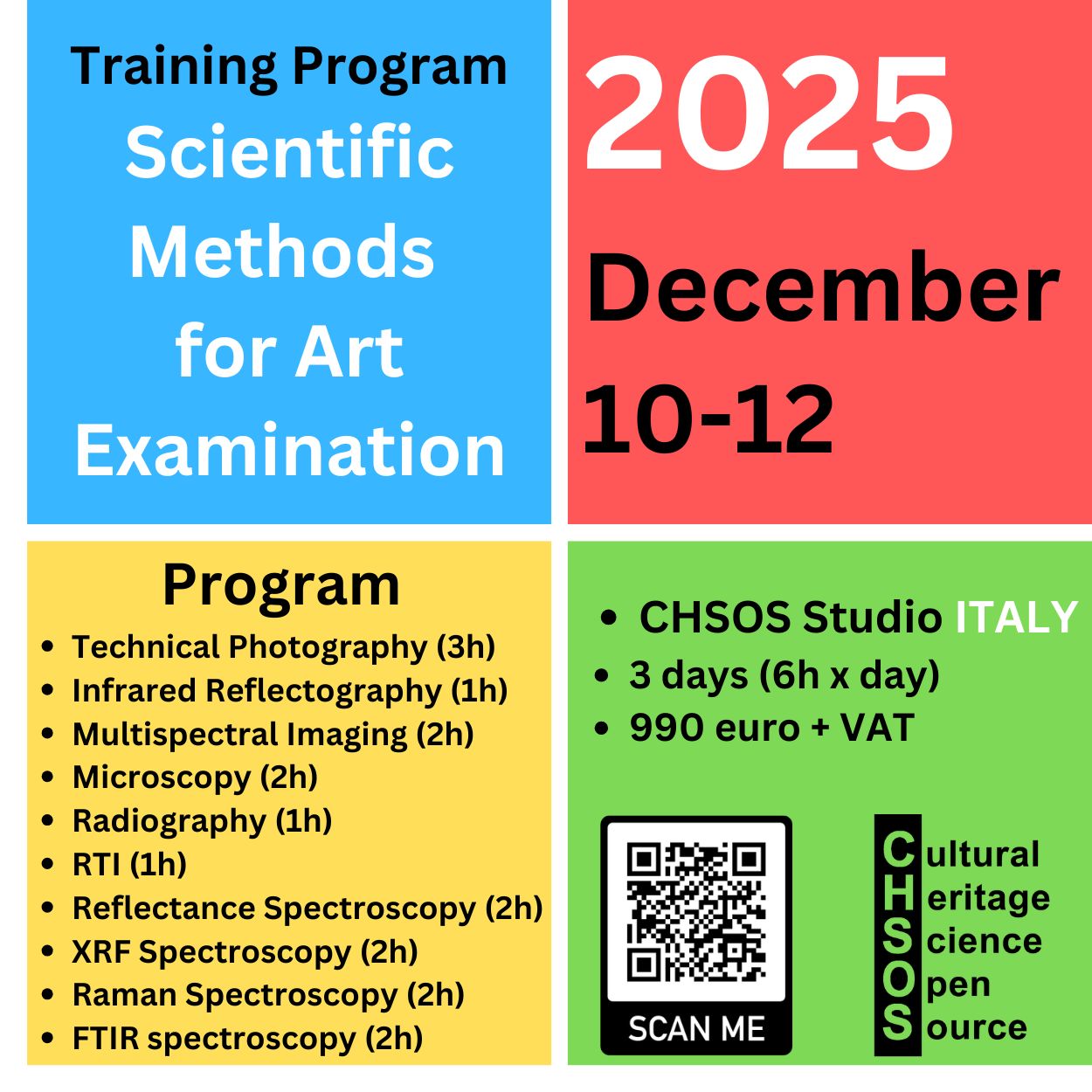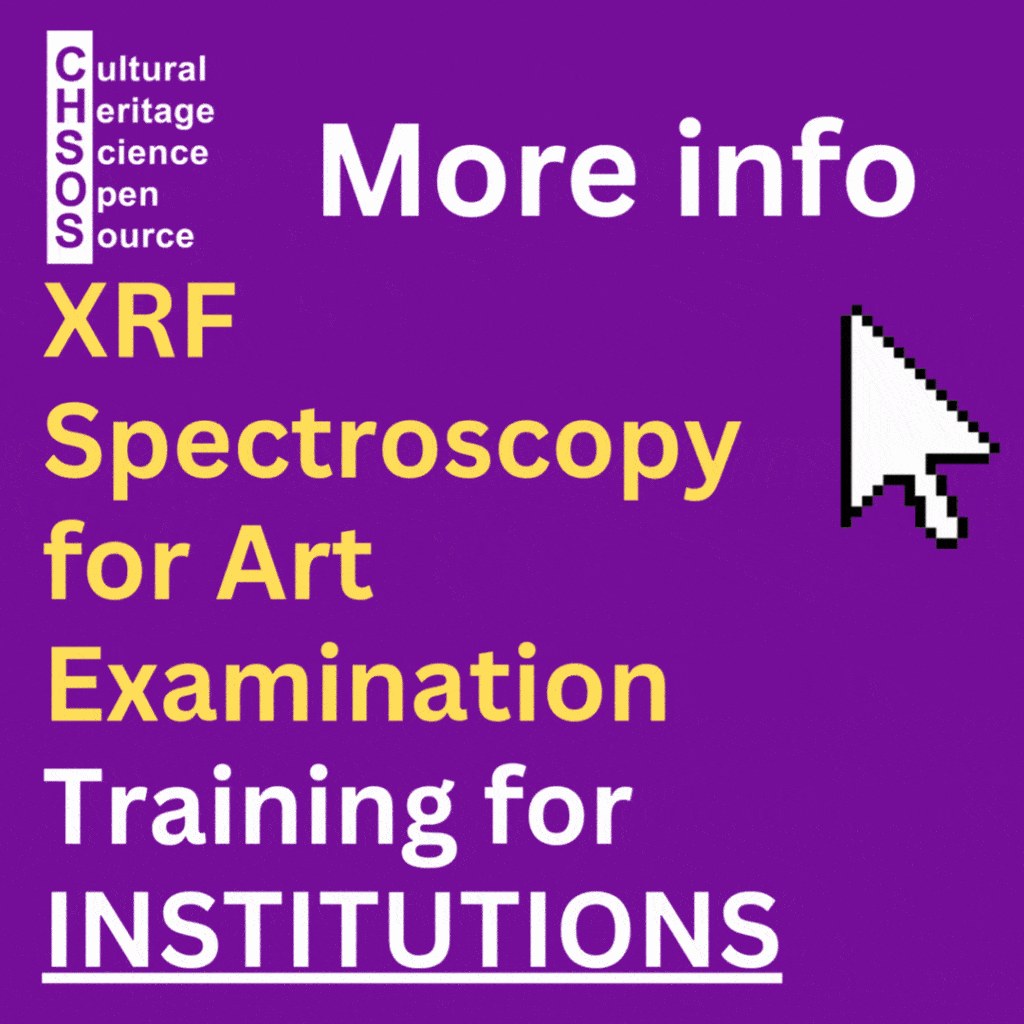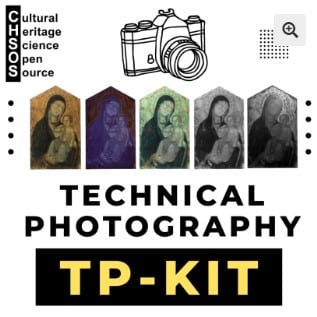Antonello – Multispectral Imaging (MSI) System for Art and Archaeology
Multispectral Imaging for Art
Conservators and art historians need non-invasive methodologies to identify and map pigments on works of art and archaeology. These tools are essential because they allow professionals to select appropriate conservation procedures, acquire information on workshop practices, distinguish original sections from inpaints, as well as enhance the visualization of faded pigments and inks.
To address this need, Antonello is our simple multispectral imaging (MSI) system composed of 18 bandpass filters, covering the 400–925 nm spectral range. Importantly, you can apply these filters to any digital camera modified for the UV–VIS–IR range. Compared to a monochromatic scientific camera, using a digital camera has the advantage that the same device can be employed for other technical photographic methods. As a result, the overall imaging equipment becomes lighter, more compact, and more affordable.
Antonello – MSI system (18 filters, plus software)

Antonello v.2. The set of 18 spectral filters, 52 mm.

Antonello V.2 — All you need is in this box! It includes 18 spectral filters, a calibration card, and a filter adapter.
With the goal of spreading this methodology among art conservation professionals and institutions, we developed Antonello, our low-cost MSI system for Art and Archaeology. Specifically, it uses in-scene gray reference targets that have been specially designed for accurate calibration. Moreover, the system is versatile and adaptable to the specific needs of different examination projects, including manuscripts, wall paintings, and easel paintings.
We designed Antonello to be user-friendly, compact and lightweight, and easy to understand, tune-up, and upgrade.
Finally, the software is simple to use—just follow the step-by-step instructions.
The filters set for multispectral imaging
This multispectral imaging system is composed of 18 bandpass filters, whose labels clearly indicate both their center wavelengths and order numbers. Specifically, the list of filters includes the following center wavelengths (in nanometers): 405, 430, 450, 467, 480, 500, 532, 560, 580, 610, 640, 671, 700, 730, 760, 840, 860, and 920.
It is important to note that these 18 filters are not equally spaced, however, they all share the same bandwidth of 10 nm. The selection of these center wavelengths was made deliberately to better capture the spectral features of historical pigments, as they correspond to specific absorption bands or inflection points relevant in the analysis of works of art.
Whites
Titanium white has a strong UV absorption band (filter at 405 nm) that goes until the violet region and distinguishes it from the other white pigments. Lithopone features the absorption bands (filters at 670 nm and 725 nm) in the red- infrared region due to its zinc sulfide component [22].
Blues
For example, Prussian blue and cobalt violet exhibit spectral maxima in the blue region, corresponding respectively to the filters at 450 nm and 700 nm. In contrast, Maya blue and indigo show inflection points in the infrared region, matched by the filters at 760 nm and 840 nm.
Similarly, smalt features a maximum in the blue region (filter at 430 nm) and a broad absorption band in the yellow region (filter at 580 nm). Meanwhile, phthalo blue shows a maximum in the blue (filter at 465 nm) and an absorption band in the infrared (filter at 920 nm). Additionally, cobalt blue presents an inflection point in the green region, which corresponds to the filter at 525 nm.
Finally, azurite and ultramarine, which both have broad maxima in the blue region, are effectively covered by the five filters ranging from 405 nm to 480 nm.
Greens
In the green pigment category, malachite, verdigris, and phthalo green exhibit maxima in the green region, corresponding respectively to the filters at 525 nm and 500 nm. By contrast, viridian shows an inflection point in the infrared, captured by the filter at 760 nm.
On the other hand, green earth presents weak absorption bands that cannot be resolved with this system; as a result, it produces a flat spectrum. Cadmium green is an exception, as it is identified primarily through its infrared fluorescence, and no filter was selected to match its spectral features.
Meanwhile, cobalt green shows a maximum at 532 nm, and the filter at 405 nm effectively outlines the maximum of chrome green in the violet region.
Yellows
Among the yellow pigments, cadmium yellow displays a sharp inflection point in the blue-green region, which is captured by the filter at 480 nm. In contrast, cobalt yellow exhibits a weak absorption band in the red region, corresponding to the filter at 610 nm.
Similarly, orpiment and saffron have inflection points outlined by the filter at 532 nm. Lead tin yellow I presents a sharp inflection point, effectively covered by the filter at 467 nm. Meanwhile, lead tin yellow II, Naples yellow, and gamboge share inflection points represented by the same filter at 532 nm.
As for earth pigments, yellow ochre, red ochre, and sienna display an S-shaped spectral feature, characterized by maxima at 600 nm and 770 nm, and minima at 645 nm, 860 nm, and 915 nm. These features correspond to the filters at 610 nm, 760 nm, 640 nm, and 920 nm, respectively.
Additionally, massicot has an inflection point at 450 nm, matched by the filter at 450 nm, while yellow lake reseda shows an inflection point at 490 nm, corresponding to the filter at 500 nm. Finally, realgar exhibits an inflection point at 560 nm, and a dedicated filter was added to cover this feature.
Reds
Among red pigments, vermilion, cadmium red, alizarin, and madder lake all exhibit inflection points around 600 nm, which are covered by the filter at 610 nm. In contrast, lac dye shows a spectral response that is highly dependent on the binders used; its inflection point varies significantly, and therefore, no specific filter was selected for it.
Meanwhile, carmine lake presents an inflection point at 630 nm, which corresponds to the filter at 640 nm. Additionally, red lead features an inflection point at 575 nm, captured by the filter at 580 nm.
Browns and black. They don’t have spectral features useful for their identification.
| center (nm) | notes |
| 405 | Titanium white absorption; chrome green maximum |
| 430 | Smalt, malachite maxima |
| 450 | Prussian blue maximum, massicot inflection |
| 467 | Phthalo blue maximum (465), lead tin yellow I (465) inflection |
| 480 | Cadmium yellow inflection |
| 500 | Verdigris, phthalo green maxima; yellow lake R. (490) inflection |
| 532 | Cobalt blue inflection; cobalt green maximum; orpiment, lead tin yellow II (525), naples yellow (515), gamboge (535) and saffron inflections |
| 560 | Realgar inflection |
| 580 | Red lead (575) inflection |
| 610 | Cobalt yellow absorption (615); ochre (600) maxima, vermilion, cadmium red, alizarin, madder lake inflection |
| 640 | Ochre (645) minimum; carmine lake (630) inflection |
| 671 | Lithopone absorption (670) |
| 700 | Cobalt violet maximum |
| 730 | Lithopone absorption (725) |
| 760 | Maya blue, viridian (770) inflections; ochre (770) maximum |
| 840 | Indigo inflection (830) |
| 860 | Ochre minimum |
| 920 | Phthalo blue, ochre (915) minima |
TP and MSI calibration card
Conventional commercial gray cards cannot be used with our multispectral imaging system, Antonello, because they absorb near-UV and violet radiation. As a result, they are unsuitable for use with the filter at 405 nm.
To address this limitation, we developed an MSI calibration card that effectively covers the entire 400–925 nm spectral range. Specifically, it includes six swatches: pure white, four shades of gray, and pure black. To learn more, explore our resources on Technical Photography and the MSI calibration card.

Splitting raw images
The photosensors of each pixel in a digital camera cannot distinguish the wavelength of incoming light. Therefore, tiny color filters are placed over the pixels to selectively capture red, green, or blue light (RGB). Subsequently, the on-camera processor converts the raw image into a full-color image by applying a demosaicing algorithm.
However, this processed image cannot be used to accurately reconstruct reflectance spectra, since the demosaicing algorithm introduces arbitrary interpolation. In contrast, our multispectral imaging system splits the raw images into their native RGB components without any interpolation, preserving the original spectral information.

Registration
Registration is the process of aligning and scaling images so that they perfectly overlap each other. In our approach, we register all 18 spectral images by taking the first spectral image as a reference for the entire set. This differs from progressive methods, which register each image to the one immediately preceding it.
Our Research on Multispectral Imaging
| Publications on Multispectral Imaging |
|---|
| A. Cosentino “Imaging Multispettrale low-cost con filtri interferenziali” Archeomatica, 2, 12-17, 2015.. |
| A. Cosentino “Multispectral imaging and the art expert” Spectroscopy Europe, 27 (2) 6-9, 2015. |
| A. Cosentino “Multispectral Imaging of Pigments with a digital camera and 12 interferential filters” e-Preservation Science, 12, 1-7, 2015.. |
| A. Cosentino “Panoramic, Macro and Micro Multispectral Imaging: An Affordable System for Mapping Pigments on Artworks” Journal of Conservation and Museum Studies, 13(1): 6, 1–17, 2015 |
| A. Cosentino “Multispectral imaging system using 12 interference filters for mapping pigments” Conservar Património 21, 25-38, 2015. |
| A. Cosentino “Crowd funded research: low-cost multispectral imaging” RECH3, International meeting on Retouching of cultural heritage. 2015. |
| A. Cosentino “Transmittance spectroscopy and transmitted multispectral imaging to map covered paints” Conservar Património 24, 37-45, 2016. |
FAQ
What is the software license? At the very least we will need to use it on multiple machines as we are a university, training students.
Software is free to share, copy, install, as many times you need and on many machines you use.
Does it only work with that particular camera or with any model?
Yes, Antonello works with any digital camera that has been modified to cover the 360–1000 nm spectral range. While we suggest two Nikon camera models, Antonello is compatible with any other suitable model as well.
Moreover, you can use Antonello’s filter set and software with the modified digital camera you already own and use for infrared and/or UV photography. Therefore, there is no need to purchase a new camera.
Does the software only work with this particular filter set and camera?
No, the software can be adapted to different filters set and cameras, as well as develop your own workflow.
If a filter gets damaged or lost, is it possible to get a replacement without having to buy a full set?
Yes, it is. Buy your replacement filter here.
Antonello 52 – Replacement filter
Case studies:
Nuremberg Chronicle
Resources
Getty Conservation Institute (GCI) – USA
-
Focuses on advanced imaging techniques including multispectral and hyperspectral imaging in conservation projects.
-
Look for research reports, case studies, and field projects involving imaging.







